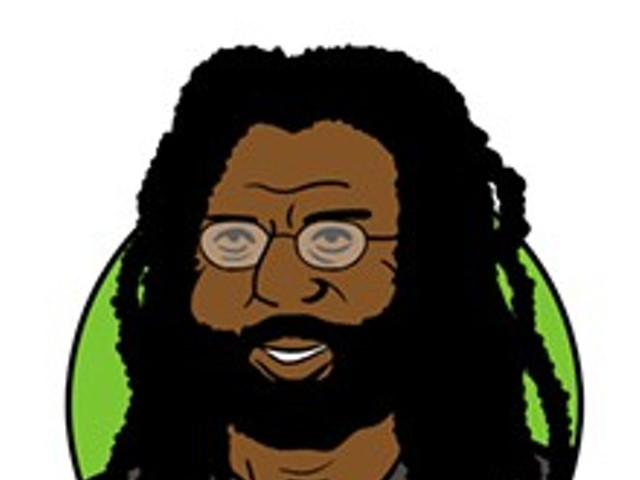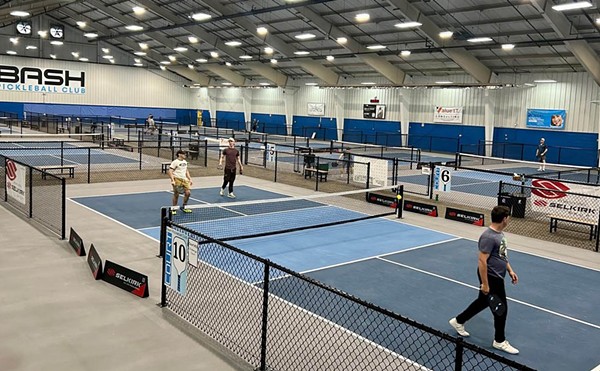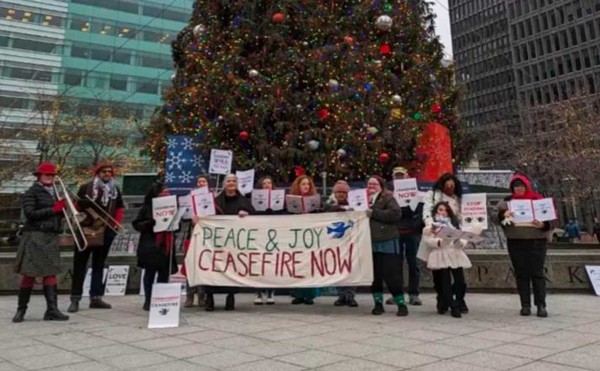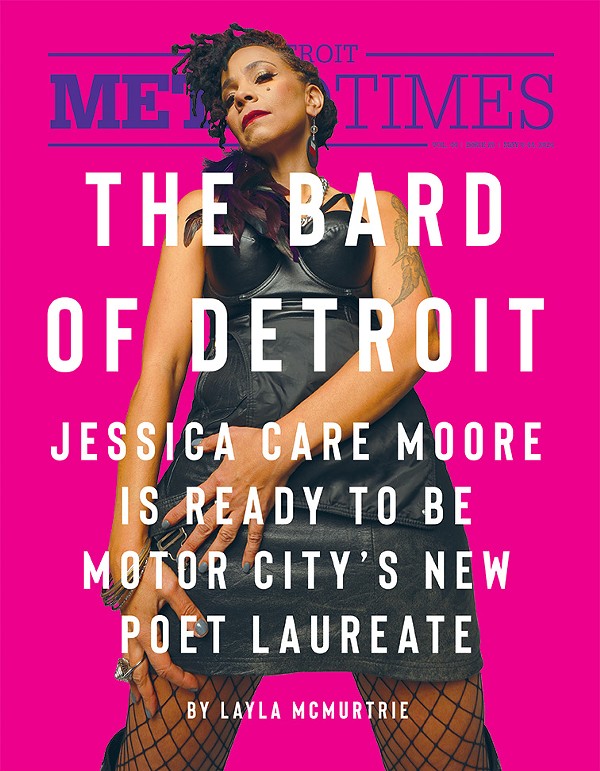The day after Christmas, we walk around the neighborhood and ask the people we meet what they call it. Despite the viaduct sign, nobody we talk to appears to know anything about the name Springwells Village. Most of the people refer to the community simply as Southwest Detroit or even Mexicantown.
Knoxx points out that caring about such issues is somewhat of a luxury. "It depends on how they get their information. People who are on the up and up and know, they don't agree with it," he says. "People who are unaware, like my mother, she has no idea what's going on. But I let her know."
Knoxx says it's hard to get people civically engaged in the community. "It's not always easy for people around here, because they're dealing with historical trauma and pain, living inside this ghetto in the '90s." Knoxx says many people are more worried about basic survival and how to pay rent. "A lot of the time, to [get people] civically engaged or to worry about these issues, they're like, 'I don't have time for this.'"
Our informal survey takes us to D & L Hardware East on Vernor. One employee says he was a native of the area but has never heard of the Springwells Village name. "Sounds like more money to me," he says. "We're far away from being considered a village."
But like Nordmoe noted, the community is like a village. We return on another day to walk around with another member of Enclave, an activist and photographer named Erik Howard. As we walk down Vernor, the sidewalks bustle with pedestrians — a rarity almost everywhere else in the Motor City. Our walk is punctuated by lots of small talk with passers-by, with people calling out Howard by name or just to comment on the unseasonably warm weather.
Howard says he has called the area home for 32 of his 36 years. And he's quick to point out that for the most part, he admires the work UNI has done in his community. He's even variously volunteered for and worked with them since 1997.
"Their model is important," he says. "They believe strongly that an organization commits to a very small part of a larger neighborhood, and they work the hell out of that neighborhood to meet community-identified needs with outside resources.
"It's brilliant. It's also kind of obvious, but it's not generally how people do it. People usually take huge swaths of an area and develop — they focus their efforts on really small parts of the neighborhood, and since they've done that, it's yielded wonderful results." Howard says he took his daughter to the park every other day over the summer, and also applauds UNI's efforts in providing opportunities for GED education and also a preschool.
But Howard himself refers to his community by its major intersection, a convention typical among Detroiters (he also notes he refuses to refer to Mexicantown by its name). That means he refers to his community by Springwells-Vernor — which we point out is not radically different from the proposed "Springwells Village." But Howard thinks it is.
"When you think of the villages in Detroit, what do you think of?" he says, referring to historically well-to-do neighborhoods like Indian Village and West Village. "The neighborhoods are very different. This process has really pandered to the attraction of new people — which is fine, that needs to be part of the process. We have a lot of empty units, but [new people] should not be prioritized over retention of current residents."
Howard takes us to a red archway built over Vernor, one of two on the neighborhood's little downtown drag. On a partition facing the street, someone has wheat-pasted a poster: "Our neighborhood is not a brand," it reads. "We Are #SWDetroit."
"A 74-year-old put that up," he says. "She asked us to print them and give them to her, and she wheat-pasted it herself."
It's part of a campaign to engage the community and, in part, get feedback on the name change. Howard says Enclave has collected more than 300 signatures on a petition that will soon be presented to UNI, which states that UNI has not "fully and authentically included the voices and input of community residents" and that "marketing efforts are focused primarily on bringing new residents in, with little focus on retaining current residents." The petition requests that UNI "create a plan to revisit the naming process" and restructure its marketing efforts to primarily focus on retention of current residents.
"It doesn't mean that you can't name something," Howard says of the campaign. "What 'Our neighborhood is not a brand' is all about is that our neighborhood is a community."
Branding should be one of the last priorities. "A lot of times when you're branding something, you're branding it so you can market it, and when you're marketing, you're marketing it to somebody who it doesn't already resonate with," he says. "You're trying to attract somebody. A lot of the efforts around the naming and branding of Springwells Village is about making the community palatable for people — who, for one reason or another, don't come or don't like it. Our point is you're talking to the wrong audience."
And Howard points out that while the Springwells Township name is historically accurate, it originally encompassed an area that was much wider than what would be called Springwells Village. "Springfield Township went all the way to Greenfield Village," he says. "That's nowhere near here. How far back to you want to go? Before that, you know that this land was stolen by somebody, right? Do you want to go back that far?"
Howard's problem is that acknowledging Springwells Township is a selective history. "There are a lot of things that are true about this neighborhood that you can assert if you want to," he says. "Four blocks from where I grew up, there was a gang that was started. That gang was created by the Native American family in collaboration with some Mexicans and whites, and it was designed to insulate their block from the negative effects of the gangs from Chicago that were moving in."
His point is that's significant too and a part of the neighborhood's history. "There's lots of things that are true about the neighborhood. I would never argue that what happened on Green Street should become our identity," he says. "But if I'm going by the same standards that UNI are, then I could state that case."
A big part of his community's reality — one that Howard says is being whitewashed by the Springwells Village campaign — is what he euphemistically refers to as the "street economy," including drug trafficking and prostitution, that is a part of everyday life for some residents.
We walk past several young women standing on the sidewalk — prostitutes participating in the local street economy, Howard points out. "These are all things that I worry about Springwells Village getting glossed over," he says. "So what do you do? Just deny those things until you have a critical mass that can just push them out? I know that's not part of your marketing materials, but that's part of the reality. Are the people you're targeting really ready to move into a neighborhood like this?
"Growing up in Southwest is like growing up in a small town in the middle of a big city," Howard says. "I've been in rooms with people that my next door neighbor killed their cousin, and they know that I'm friends with that person, but I get a pass because I wasn't on the corner.
"Everybody's related," he continues. "We all lived on the same blocks as each other. If you grew up on Carson, everybody who grew up on Carson is your family. You don't always like your family."
If Detroit is, in fact, ruled over by nonprofit fiefdoms, the ruler of them all might be Midtown Detroit, Inc. Its neighborhood, Midtown, has become synonymous with Detroit's recent redevelopments, hosting major cultural institutions like the Detroit Institute of Arts and Wayne State University as well as an influx of trendy restaurants in recent years. And after changing its name five years ago from the University Cultural Center Association to Midtown Detroit, Inc., it's now nearly impossible to untangle Midtown the nonprofit from Midtown the neighborhood.
In other words, this neighborhood very much is a brand. And its president, Sue Mosey, is quick to refer to it as one.
She tells us by phone that she first saw the need for a unifying identity for the neighborhood 15 years ago. "We realized that it was very difficult to come up with anything that was meaningful to translate into signs or translate into area guides or any kind of applications if we didn't have sort of a brand name for the entire neighborhood," Mosey says, noting that the area was comprised of a myriad of smaller neighborhoods already — Art Center, Cass Corridor, and Brush Park, among others.
She denies that the powerful Midtown moniker had anything to do with scrubbing individual existing neighborhood brands clean of tarnished histories. (A joke in the Metro Times office goes that in the local media, people get mugged in the Cass Corridor; new restaurants open in Midtown. Mosey tells us she has not heard that joke.)
Mosey says she encourages individual neighborhoods to continue using their names in addition to the larger Midtown umbrella. "We needed to have one larger geography as we're building out in the neighborhood so that it's all becoming more connected, so that people know that when you're going to Midtown, you're going to have all these different options that you could go to," she says. It also helps that the Midtown brand was already familiar — plenty of other major North American cities have their own Midtown with similar cultural assets.
Mosey also attributes the success of Midtown to its 200 "members," or participating institutions and businesses that plug the brand as well.
"We don't spend a lot of money on marketing," Mosey says. "But what we do have is 200 members. And when they all start using 'Midtown' as their brand, then you really start to reach scalable audiences.
"And the first people that really picked up on the Midtown thing and really helped us were the media, quite frankly. So obviously you could see it was also solving sort of a problem with the media of how to describe things going on in this geography that really didn't have a name either."
Attaching the brand to tangible things helps to make the connection in people's minds, Mosey says — like creating new construction projects and throwing annual events like Dlectricity and Art X Detroit. Even the Dally in the Alley block party, long a Cass Corridor institution, gave in and latched onto the Midtown brand in a press release four years ago.
In all, Mosey says, it took "Midtown" the neighborhood more than a decade to fully catch on with people. "It's not an overnight thing," she notes. "You just have to keep working at it."
Names, of course, don't really mean anything unless people agree on their meaning. At the end of the day, neighborhoods aren't things. They're made up of people, and in everyday speech, the people are the ones who ultimately will give their neighborhood its name, despite what a hand-painted sign might suggest they say.
Whether "Springwells Village" catches on depends on its residents. But oftentimes, life can have a funny way of imitating art — or branding — especially if its plugged by media over and over again.
[Update 2:18 p.m. on Wednesday, Jan. 7] An earlier version of this story implied that Nordmoe is a Detroit native. Although he has lived in Detroit for 30 years, he is originally from Grant Park, Ill.






